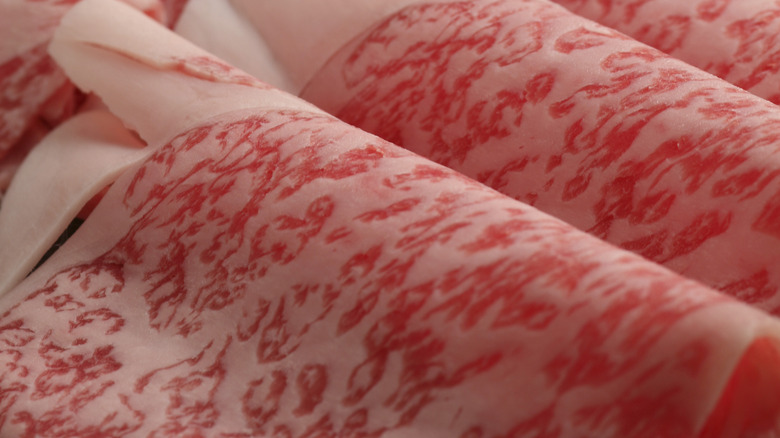What Is Japan's Wagyu Olympics And When Did It Get Its Start?
Wagyu (pronounced wah-gyoo, not wah-goo, per Robb Report) beef is well-known for being jaw-droppingly expensive and made from a special breed of Japanese cattle (via American Wagyu Association). "Wa" translates to Japanese and "gyu" to cow, so the word literally translates as Japanese beef. This cut is prized for its distinctive marbling texture, tenderness, high levels of omega fatty acids, and buttery flavor, and the cattle normally have been raised in a stress-free environment, reports BBC Good Food.
However, raising any cow the Wagyu way won't get you the same result: Wagyu beef is derived from four certain breeds which are more genetically disposed to creating that marbled texture: the Japanese Black (the dominant breed), Japanese Brown, Japanese Polled, and Japanese Shorthorn, per American Wagyu Association. And according to KNK Yakiniku, this attention to detail in the quality of wagyu beef has led to the creation of its two-part grading system, which rates the quality, A-class to C-class, and the marbling in the fat, 1 to 5.
When there's a way to score and rank meat, competition follows, and Japan is the birthplace of the Wagyu Olympics — where muscle goes toe-to-toe, alive, and then dead.
Zenkyo, a beef competition launched in 1966
Once known as Zenkyo, the Wagyu Olympics is a hybrid between a festival, trade show, and competition that is held every five years. It was launched as a way to promote tourism, cattle breeding, and the appetite for Wagyu beef in 1966, as reported by BBC.
According to the South China Morning Post, the competition consists of two categories: breed improvement and meat quality. The former category judges a cow on its appearance and size, whereas the latter category then judges the meat fat quality, content, and taste. The most recent Wagyu Olympics drew over 400,00 visitors and was held in October (via Japan Times). The 2022 theme? In rough translation — "shining a spotlight on the power of regional Wagyu beef," per BBC.
While the traditional Olympics feature competitors from different countries, the Wagyu Olympics comprise competitors from different Japanese prefectures, with the strongest cattle coming from the Miyazaki and Kagoshima prefectures (via South China Morning Post). Like Olympic athletes, each cattle competitor also has a name since each pure-bred Wagyu cattle must be given a name at birth and a 10-digit identification number, as reported by Tokyo Creative (via YouTube).
The 2022 Wagyu Olympics is a pursuit of excellence and labor
Attendees of the 2022 Wagyu Olympics, hosted in Kagoshima, Kyushu, were treated to a festival of tourism booths, farming goods, and free morsels of premium beef, as shown by YouTubers Tokyo Creative. Meanwhile, 438 cow "athletes" from 41 different prefectures were treated to warmed water baths and shampoo treatments to get stage-ready for the opening ceremony, per Kyodo and YouTube.
For the farmers, the cows are not just products to be sold but animals that are cared for with love and respect, in the pursuit of excellence and in the philosophy of ikigai, which means what gives life meaning or purpose (via Positive Psychology and BBC). Three generations of cattle are displayed at the Olympics, showing pride in the lineage of the cows, according to the Kobayashi City Promotion Company.
As reported by Kyodo, the Kagoshima prefecture bull won the breed improvement category, while the Miyazaki prefecture bull won first place for beef quality. If you're interested in attending the Wagyu Olympics or want to get your hands on some authentic wagyu beef, mark your calendars: The next one will take place in 2027 in Hokkaido.


